
Another great dawn low tide, this time north of San Simeon about three miles SE of Piedras Blancas lighthouse,
San Luis Obispo Co., CA.
| 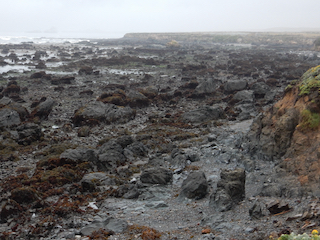
-
| 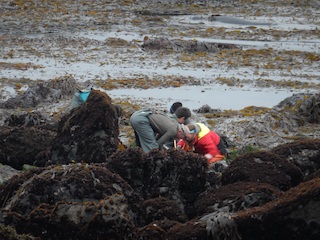
-
|
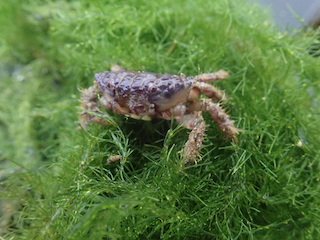
-
| 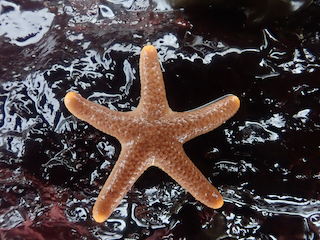
-
| 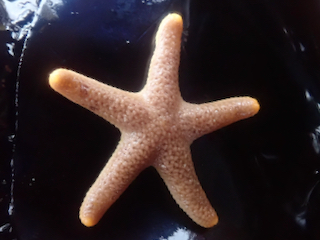
Red algae can be so effective at absorbing visible light that it can make a convenient background for
a macro photograph of a Henricia pumila (dwarf or mottled brooder Henricia), with an easy tweak assist from Photoshop in the next one).
|
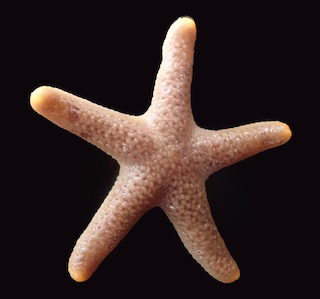
-
| 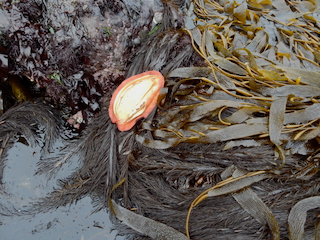
-
| 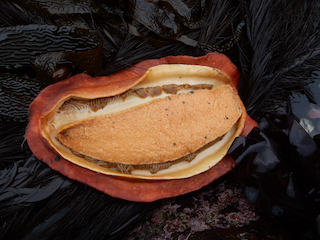
-
|

-
| 
I measured it at 11 inches (27.9 cm) in the field, which is not an unusual size for Cryptochiton stelleri.
It was stranded like this at the minus low tide, but this is normal and would have crawled away soon enough if I had not helped it return to underwater a bit earlier.
| 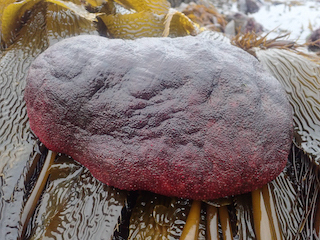
Cryptochiton stelleri a.k.a. wandering meatloaf
|
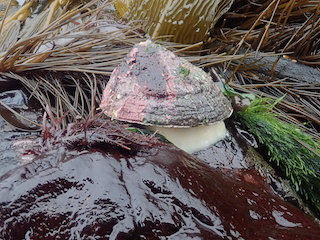
Diodora aspera (rough keyhole limpet)
| 
A passing encounter with Mopalia lignosa (woody chiton) and Calliostoma ligatum (blue topsnail).
Looking closely will reveal a much smaller adult snail on the far right, Lirularia sp. (I am struggling to distinguish L. succincta (Carpenter, 1864), from
L. discors McLean, 1984.)
These two (or one) species are our only member(s) of Trochidae that one is likely to find (if one notices 3mm wide snails) in the low intertidal of central California,
and members of the family are typically only found in the subtidal further south in southern California. (Cont.)
| 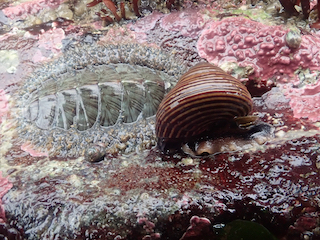
(Cont. 1) Members of this particular genus are thought to be closely related to snails in England (also in the subfamily Umboniinae) that were studied by accomplished
molluscan anatomist, Vera Fretter (1975; J. Zool., Lond. 177: 541-552). She found they were suspension feeders eating plankton.
This is highly unusual within the species-rich Trochidae, which has about 78 other accepted genera and hundreds
of species worldwide (many or most much larger than these).
Suspension feeding is also highly unusual across all of Trochoidea (the superfamily including also families better represented on our coast:
Tegulidae, Turbinidae, and Calliostomatidae). (Cont.)
|
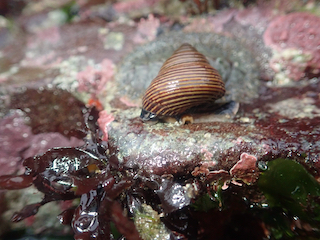
(Cont. 2) In fact, it is unusual among the even broader group of vetigastropods (i.e., also including abalones, keyhole limpets, etc.).
More typical Trochoidea (and Vetigastropoda in general) tend to feed on algae or scrape diatoms off rocks. Some trochoidean snails, like this
Calliostoma ligatum (and other Calliostomatidae) are more likely to graze on colonial animals instead of marine plants,
but this seems much less of a departure from normal within Trochoidea than suspension feeding. (Cont.)
| 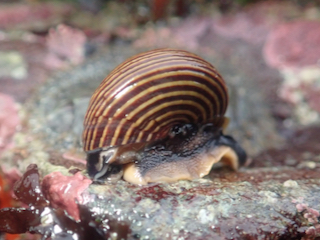
(Cont. 3) To date there has been conflicting evidence presented so
it is still not certain whether or not our Lirularia are suspension feeders, and even if so they might be still be facultative feeders
more like other trochid snails. They are very actively crawling tiny snails with quite colorful shells.
| 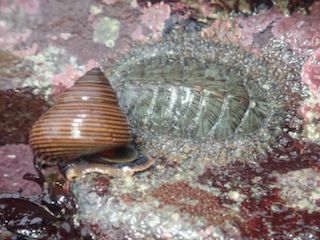
-
|
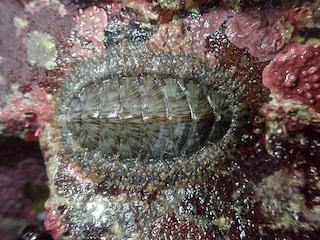
-
| 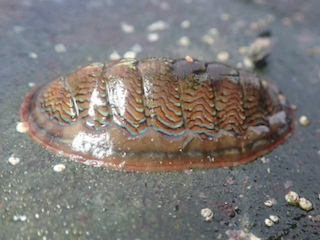
A fairly large Tonicella lokii (Loki's lined chiton).
| 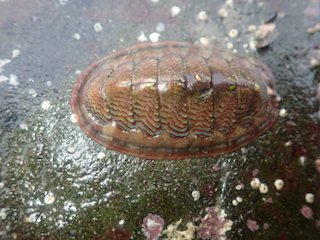
-
|
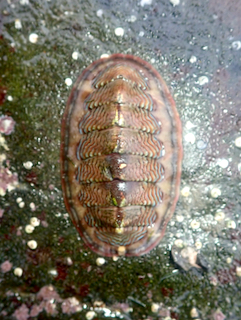
-
| 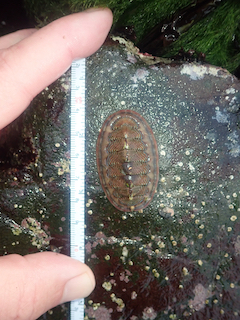
-
| 
-
|

-
| 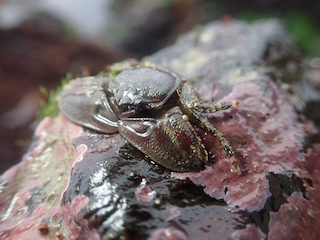
Petrolisthes cinctipes (flat porcelain crab)
| 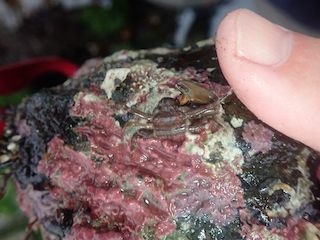
-
|
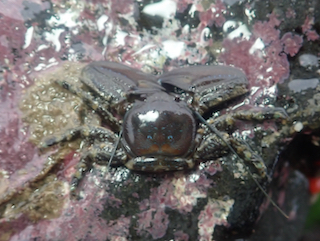
-
| 
-
| 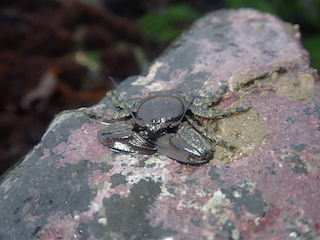
-
|

Diodora aspera ventral side observed in the field. I was hoping to see
Arctonoe vittata, a mutualistic polynoid scale worm that is commonly in the keyhole limpet's mantle cavity, but I did not find one this time.
| 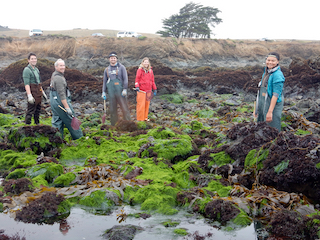
Professor Scott Hamilton and his crew collecting juvenile pricklebacks for aquaculture research at
Moss Landing Marine Lab. They were also staying at Rancho Marino Reserve and were already out chasing pricklebacks some time before sunrise.
| 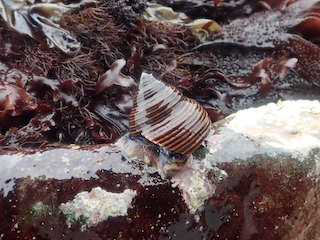
-
|

-
| 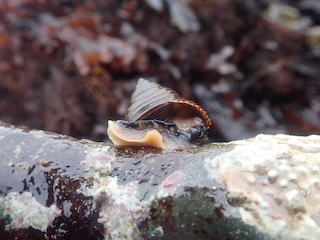
-
| 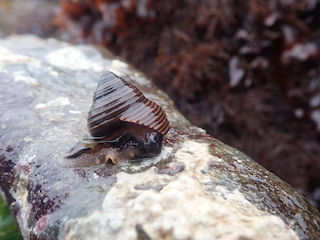
-
|

This trip, I learned about Photis conchicola, an interesting gammarid
amphipod that is common in the intertidal of California's Central Coast. It is a suspension feeder that lives inside small snail shells, and it seemed to be even a
more common occupant of the tiny empty snail shells I was finding than hermit crabs.
The amphipod spins a silk web with a siphon-like opening. I found John Carter's (1978) great Cal Poly SLO Master's
thesis and his later published version (1982). Asking my colleague Tim Stebbins if he could confirm my identification as P. conchicola
from the key in Light and Smith Manual soon had me in touch with local amphipod experts. They kindly provided helpful resources
about this shell occupant, and I learned that Don Cadien (2015) has written a fascinating account of this and other often ubiquitous California
Photidae.
- Source 1982 -
Source 2015
| 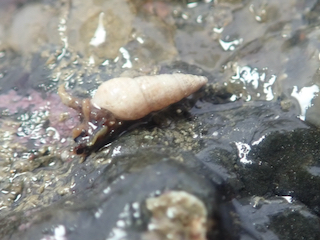
-
| 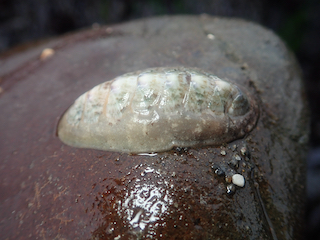
-
|
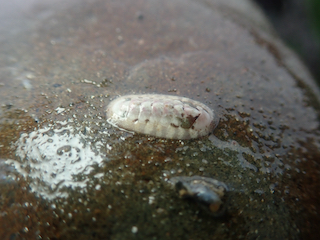
-
| 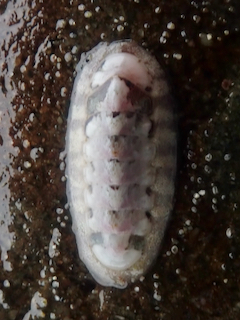
-
| 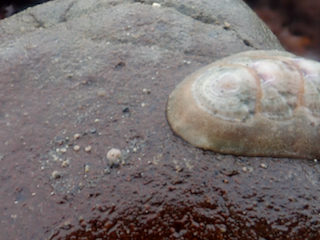
They can be much more common than this but the Heath's chiton crawling away has left
several tiny snails, Vitrinella oldroydi. In a recent publication, we (Goto et al. 2021) proposed that these snails are specialized
feeders on the chiton's fecal pellets. They are associated at least with Stenoplax heathiana (this species) on California's Central Coast and
S. conspicua further south. - Source 2021
|

-
| 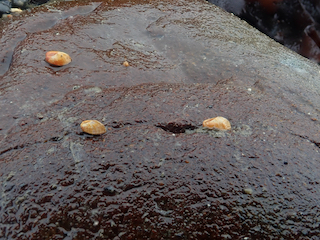
-
| 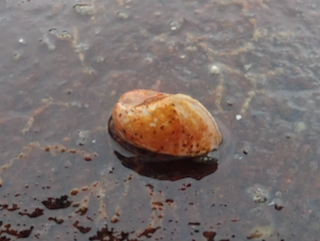
-
|
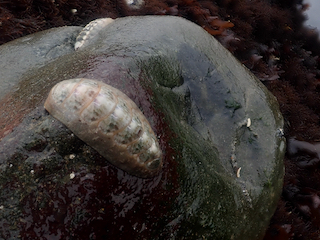
-
| 
-
| 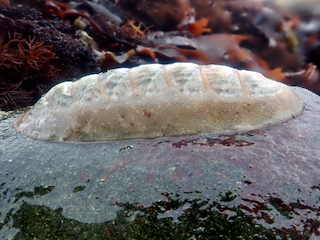
-
|
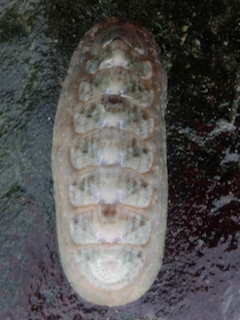
-
| 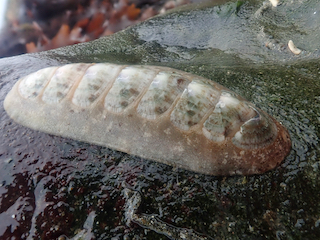
Stenoplax heathiana (Heath's chiton)
| 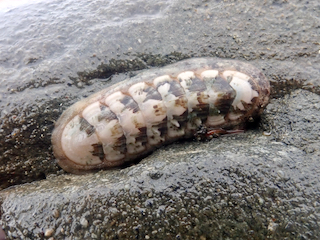
-
|
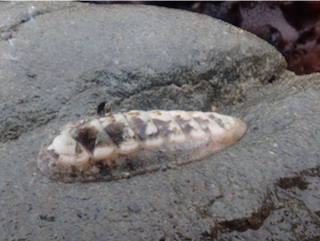
-
| 
-
| 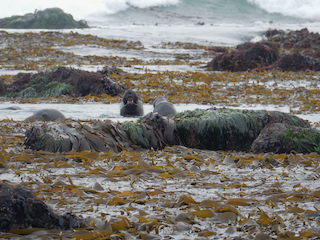
northern elephant seals (Mirounga angustirostris)
|
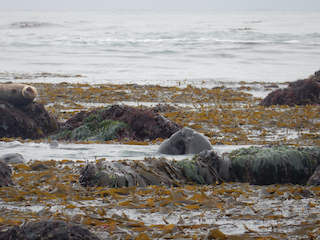
-
| 
-
| 
-
|

-
| 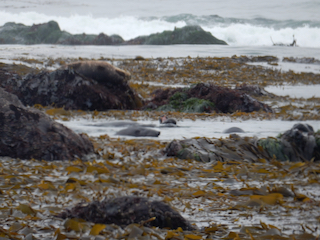
-
| 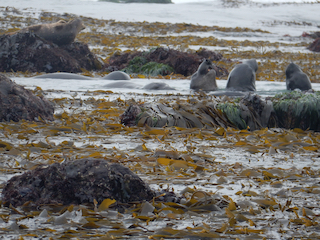
-
|
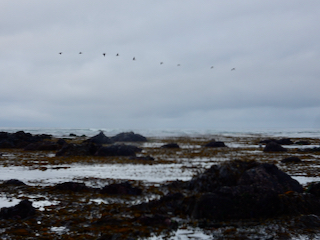
-
| 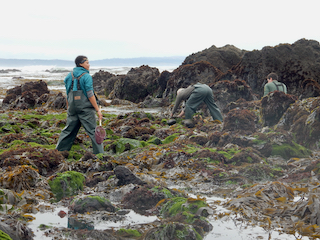
-
| 
A "flat white" Crepidula sp. In my experience, these are still problematic within California,
but see Rachel Collin's (2019) review of the family for the NE Pacific. - Source 2019
|
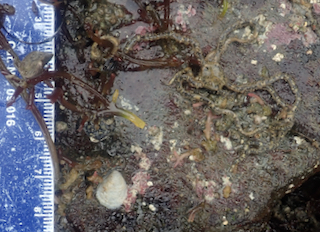
-
| 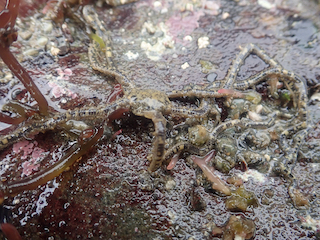
Very tentative identification: Amphiodia occidentalis (long-armed brittle Star)
| 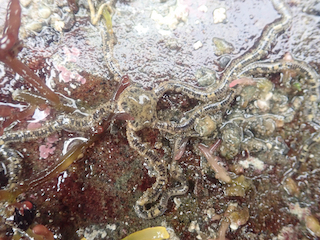
-
|
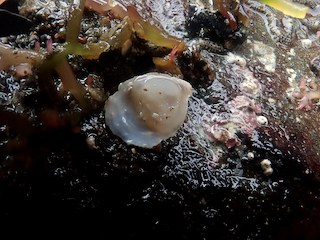
-
| 
-
| 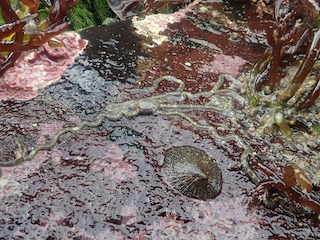
juvenile Lottia limatula (file limpet)
|
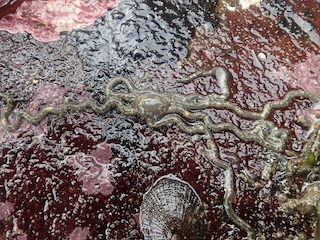
-
| 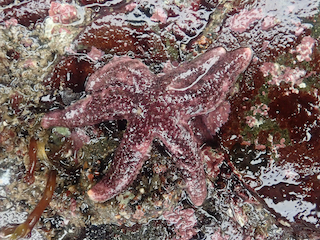
The Leptasterias aequilis species complex was recently separated into seven separate molecular
groupings by Melrose and Cohen (2021), who found differences in which groups dominated from site to site, some with more than a century of sampling.
The striking genetic differences are likely related to the way females within this genus brood large yolky embryos, eventually with crawl-away juveniles. There is
no opportunity for planktonic dispersal of larvae as found in most seastars.(Cont.) -
| 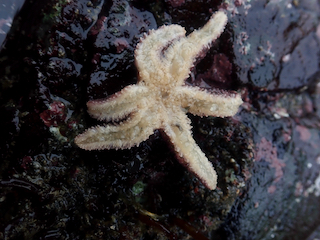
(Cont.) One of the seven molecular groupings in their study corresponds to a species, unlike the other
others, with an accepted name in use, L. pusilla. In Chris Mah's key to the seastars of central California to Oregon in the landmark Light and
Smith Manual 4th Edition (2007; ed. J. T. Carlton), L. pusilla differs in not having the spines in the upper arms
(abactinal skeletal ossicles)
in distinct rows as they are in L. aequilis. This distinction can be difficult to observe in live animals because soft tissue
covers the spines, but in a denuded preserved specimen the spines should be in a parallel row if it is one of the six molecular groups
known presently as L. aequilis, and I think I can see such a row of spines in the previous image, on one of the arms.
Another accepted species, L. hexactis, only occurs in Washington and further north.
Source 2021
|
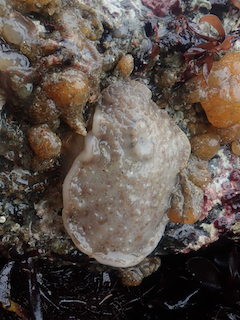
A somewhat rare two-spot keyhole limpet,
Fissurellidea bimaculata, whose mantle completely covers its quite small keyhole limpet shell.
I have probably found fewer than ten of these in all my tidepooling years, but as in this one I have gotten the impression that it is probably
feeding on the surrounding colonial tunicates. Sometimes there are even more obvious grazing scars.
Likewise, this diet was documented the 1980 classic book, Intertidal Invertebrates of California (Morris, Abbott and Haderlie,
with Text Contributions). In their marine snails chapter, Don Abbott (tunicate expert) and Eugene Haderlie report observing F. bimaculata
(known then as Megatebennus bimaculatus) feeding on these tunicates in the lab.
They further found ascidian tunicates in this species gut, along with sponge spicules.
| 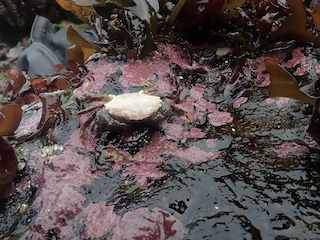
-
| 
-
|

-
| 
-
| 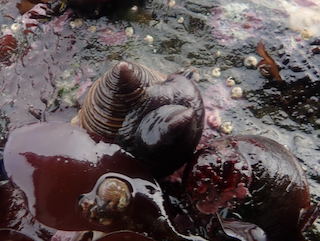
-
|

This pair of slipper limpet (I have tentatively identified as Crepidula norrisiarum)
are living on Calliostoma ligatum.
(See also the Tegula brunnea below.) These would have been assumed to be C. adunca until recently. I am studying these slipper limpets that are
on other hosts besides Tegula funebralis as a follow-up to our recent publication with my undergraduate
research student, Erica Spence. We published (Castelin et al. 2022) the surprising discovery that a related species, C. norrisiarum, which was thought
to be a more southern species normally living
on Norris's top snail (Norrisia norrisii) is not restricted to southern California. (Cont.)
| 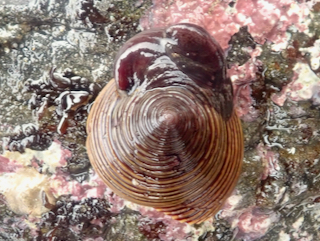
(Cont.) Instead, we found that it is common as far north as British Columbia, where it is most often found on
Calliostoma ligatum, as in these
slipper limpets. In the north, C. adunca is (as in central California) more normally found on the outer more exposed coast living on Tegula funebralis.
In fact, C. norrisiarum is the only of these two species living in the vicinity of the San Juan Islands in Washington where multiple studies were conducted
with the slipper limpets mistakenly identified as C. adunca. - Source 2022
| 
As is typical for the entire family, Calyptraeidae, Crepidula reproduction involves
sequential hermaphroditism, first maturing as a male and later switching to female. There is often a pair as there is here with the larger bottom slipper limpet being a
female. Removing it reveal that it was brooding early-stage embryos.
In both C. adunca and C. norrisiarum, the embryos are brooded until juvenile slipper limpets crawl away.
|
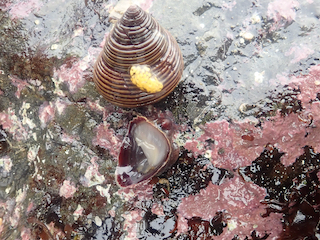
-
| 
-
| 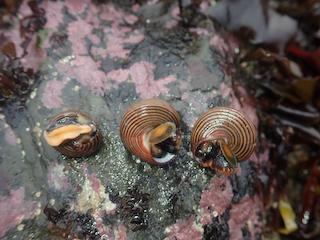
-
|
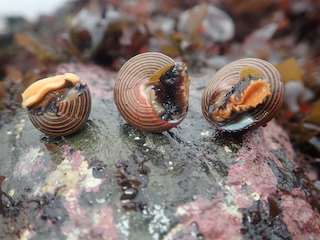
-
| 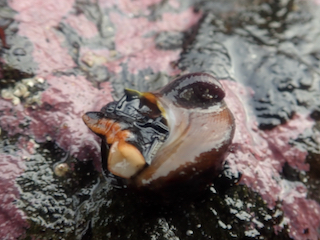
A rather small Tegula brunnea (brown teguline snail) with a single slipper limpet attached.
| 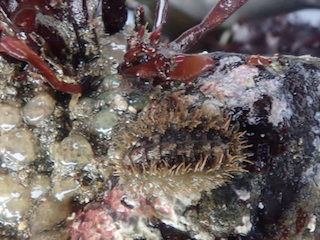
A juvenile mossy chiton, Mopalia muscosa.
|

-
| 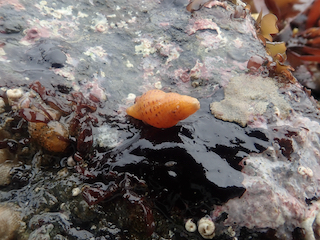
A muricid snail that is extremely small for its species-rich genus,
Paciocinebrina pseudomunda Houart, Vermeij & Wiedrick, 2019, kindly identified by Shawn
Wiedrick - Source - 2019
| 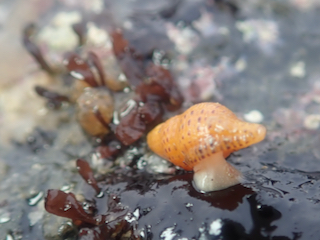
-
|
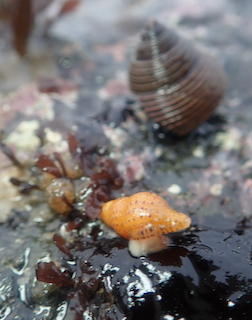
-
| 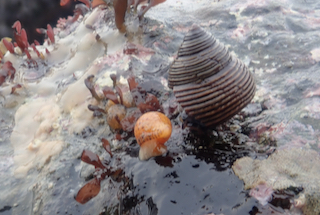
-
| 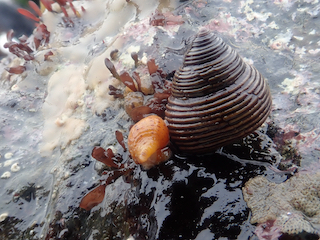
-
|

-
| 
-
| 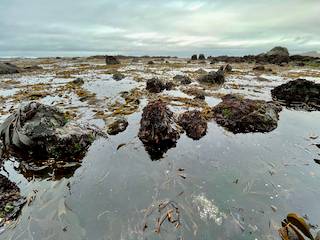
-
|

harbor seals (Phoca vitulina)
| 
-
| 
-
|
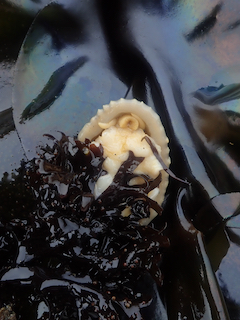
-
| 
Diodora aspera
| 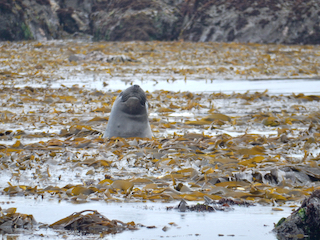
-
|
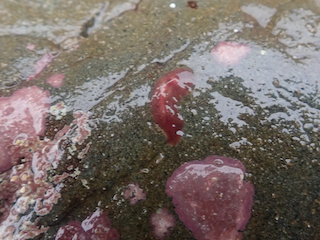
The two red polyclad flatworms in this and the next image have been tentatively
identified as a color form of Notocomplana sp. by polyclad expert, Tony Phillips.
| 
-
| 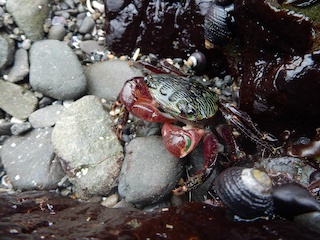
Pachygrapsus crassipes (striped shore crab)
|
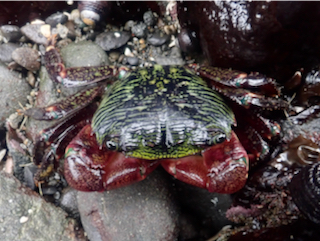
-
| 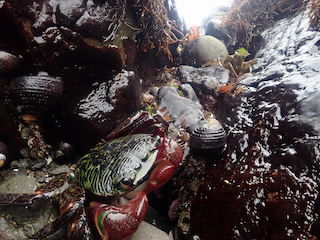
-
| 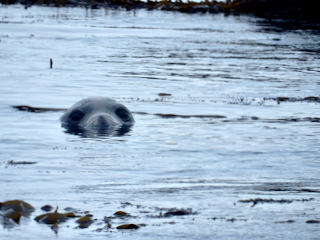
-
|

-
| 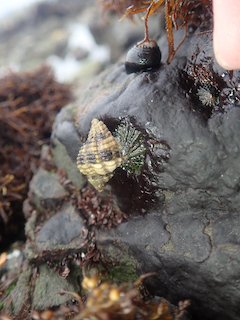
The predatory muricid snail, Paciocinebrina circumtexta (formerly in the genus Ocinebrina),
drilling a limpet, Lottia scabra (rough limpet). They are common in the intertidal of central California and their typical prey is Lottia spp.
I have found them drilling other non-limpet prey but only rarely.
| 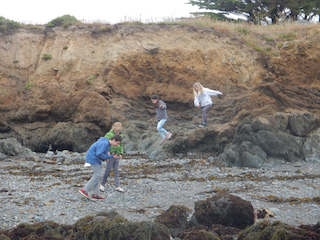
-
|
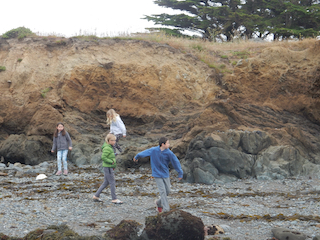
-
| 
-
| 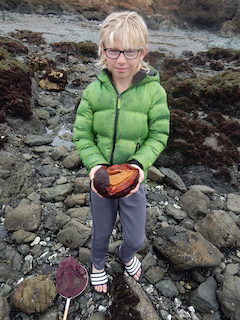
-
|
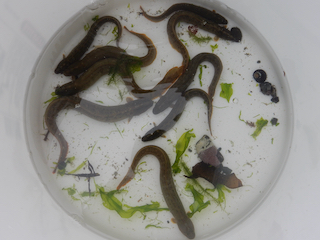
Some of the juvenile Cebidichthys violaceus or monkeyface pricklebacks
that were collected by Moss Landing Marine Lab scientists for an aquaculture project. This species ranges north to Oregon and is fairly rare south of Point Conception but has been reported as
far south as Bahia San Quintin in Baja California, Mexico. According to California's DFW website, they can grow up to over 76 cm (30 in.) in length and weigh up to 2.3 kg
(6 lbs.). According to the Monterey Bay Aquarium website, they can breath air and remain out out of water for up to 35 hours. After feeding on zooplankton at first, they
mostly eat red or green algae (Wikipedia).
- CDFW Source
- MBA Source
- Wikipedia Source
| 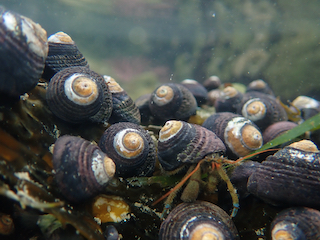
Pagurus samuelis (blueband hermit) among a bunch of Tegula funebralis (black teguline snails) feeding
on drift kelp in a tidepool.
| 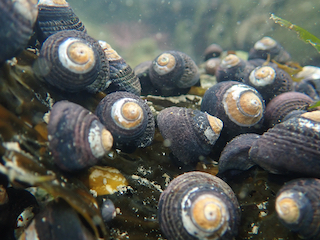
-
|
 Under Construction!
Under Construction! Under Construction!
Under Construction!